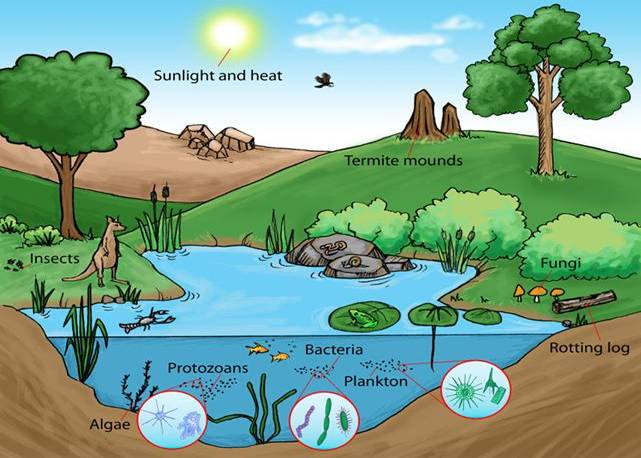
What are Ecosystems?
The grouping or assemblage of plants, animals, and microbes we observe when we study a natural forest, grassland, pond, coral reef, or other undisturbed area is referred to as the area’s biota (bio, living) or biotic community. Importantly, the plant portion of the biotic community includes all vegetation, from large trees down through microscopic algae. Likewise, the animal portion includes everything from large mammals, birds, reptiles, and amphibians through earthworms, tiny insects, and mites. Microbes encompass a large array of microscopic bacteria, fungi, and protozoans. Thus, one may speak of the biotic community as comprising a plant community, an animal community and a microbial community.
The particular kind of biotic community that we witness in a given area is, in large part, determined by abiotic (meaning non-living chemical and physical) factors, such as the amount of water or moisture present, temperature, salinity, and soil type. These abiotic conditions both support and limit the particular community. For example, a relative lack of available moisture prevents the growth of most species of plants, but supports certain species, such as cacti; we recognize such areas as deserts. Land with plenty of available moisture and suitable temperature supports forests. Obviously, the presence of water is the major factor that sustains aquatic communities.

The first step in investigating a biotic community may be to simply catalogue all the species present. Species are the different kinds of plants, animals, and microbes. Each species includes all those individuals that have a very strong similarity in appearance to one another, and which are distinct in appearance from other such groups (Robins and Mallard ducks for example). The similarity in appearance implies a close genetic relationship. Indeed, the biological definition of a species is the entirely of a population that can interbreed and produce fertile offspring, whereas members of different species generally do not interbred or, if they do, fertile offspring are not produced. Breeding is often impractical or impossible to observe, however, so for purposes of identification the aspect of appearance suffices.
In cataloguing the species of a community, one will observe that each species is represented by a certain population – that is, by a certain number of individuals that make up the interbreeding, reproducing group. The distinction between population and species is that the term population is used to refer only to those individuals of a certain species that live within a given area, whereas the term species is all inclusive – it refers to all the individuals of a certain kind, even though they may exist in different populations in widely separated areas.